◆ 研究成果
Chiral-Split Magnon in Altermagnetic MnTe
Recently, spin-symmetry classifications identified a third collinear magnetic class, altermagnetism, named after the alternating spin polarizations in both real and reciprocal spaces [1,2]. The magnets in the class, altermagnets, combine the features of conventional ferromagnets and antiferromagnets; zero net magnetization in the unit cell and spin-splitting electronic bands due to the non-relativistic exchange origin. In addition to the electronic bands, the altermagnetic magnon bands are theoretically predicted to exhibit chiral splitting as well [3]. The linear dispersive chiral magnons in altermagnets reach the THz frequencies near the Brillouin zone center, unveiling the potential for the stray-field-free ultra-fast spintronics [1,2]. Though recent photoemission spectroscopy experiments provide evidence for the altermagnetic spin-splitting electronic bands [4-6], the altermagnetic magnon bands have not been observed yet.
In this work, inelastic neutron scattering (INS) experiments were performed on single crystals of the altermagnetic candidate MnTe by using HRC spectrometer at J-PARC. Well-defined magnon excitations were observed at T = 10 K. In the spectra, giant unconventional splitting of magnon dispersions is clearly observed, as shown in Figs. 1(a) and 1(c). The split dispersions are well explained by the linear spin-wave theory (LSWT) calculation considering a Heisenberg spin Hamiltonian with a pair of alternating exchange interactions. The calculated neutron chiral factor further demonstrates the chiral splitting of the magnon dispersions, as shown in Figs. 1(b) and 1(d). Moreover, the g-wave harmonic symmetry [Fig. 2(c)] of altermagnetism in MnTe is verified in the constant-energy slice, as shown in Fig. 2(a), and is reproduced by the calculation, as shown in Fig. 2(b). Our results confirmed altermagnetism from the perspective of spin excitation and highlighted its non-relativistic exchange origin, establishing a firm foundation for future explorations in this new magnetic ground state. This work will be published in Physical Review Letters [7].
[1] L. Šmejkal et al., Phys. Rev. X 12, 031042 (2022).
[2] L. Šmejkal et al., Phys. Rev. X 12, 040501 (2022).
[3] L. Šmejkal et al., Phys. Rev. Lett. 131, 256703 (2023).
[4] J. Krempaský et al., Nature 626, 517 (2024).
[5] S. Lee et al., Phys. Rev. Lett. 132, 036702 (2024).
[6] T. Osumi et al., Phys. Rev. B 109, 115102 (2024).
[7] Z. Liu, M. Ozeki, S. Asai, S. Itoh, and T. Masuda, Phys. Rev. Lett. 133, (2024) 156702.
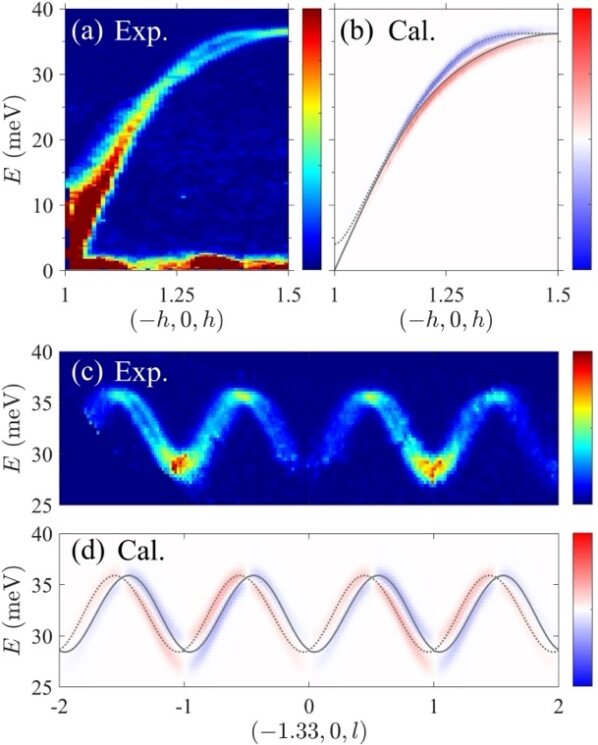
図1: (a)(c) Observed magnon spectra at 10 K. (b)(d) Calculated magnon dispersions (dashed and solid gray curves) and neutron chiral factors by LSWT.
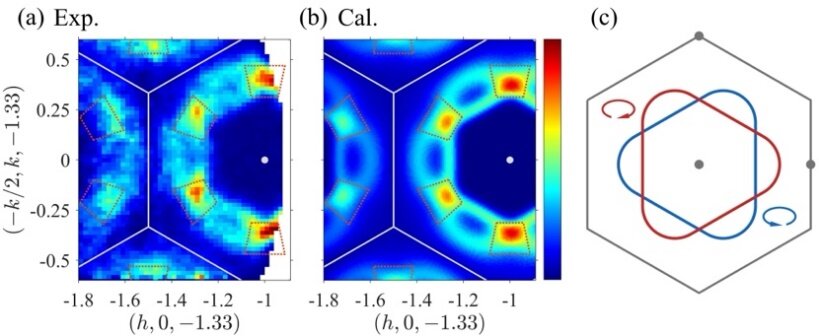
図2: Constant-energy slices of (a) observed and (b) calculated magnon spectrum. The sixfold high intensity nodal points are highlighted by the red dotted trapezoids. The Brillouin zones are shown by the solid white lines. (c) Schematic of g-wave harmonic symmetry of the magnon bands.
スピン1/2パイロクロア反強磁性体Na3Co(CO3)2Clにおける結晶場励起
通常磁気モーメント間に相互作用を有する磁性体は温度を下げると磁気秩序を示す。一方で、磁気モーメント間の相互作用に競合が存在するフラストレート反強磁性体は温度を下げても秩序せず特異な磁気状態を実現すると期待され、その基底状態を解明すべく理論的・実験的な研究が進められてきた。パイロクロア反強磁性体[下図(a)]はフラストレート反強磁性体の一つであり、正四面体が頂点共有することで三次元的なネットワークを形成する。古典的な磁気モーメントから構成されるパイロクロア反強磁性体は、特異的に大きな縮退度を有することで磁気秩序しない、古典的な液体状態を示すことが知られている[8]。一方で、量子力学的な効果を入れた場合の基底状態については、様々な理論的提案があるものの明らかになっていない。実験的にパイロクロア反強磁性体の基底状態を実験的に解明すべく、我々はスピン1/2のパイロクロア反強磁性体Na3Co(CO3)2Clの磁性を放射光X線回折実験や中性子非弾性散乱実験等の複数の実験的手法を用いて調べた。
中性子非弾性散乱実験はJ-PARC MLFにおける高分解能チョッパー分光器HRCを用いて行った。下図(b)に得られた非弾性散乱スペクトルを示す。強度の大きな2本の結晶場励起が34.6と44.8 meVに観測された。中性子非弾性散乱実験を含む複数の実験結果から、低温ではCo2+は疑似的なスピン1/2の自由度を持ち、その基底波動関数は一軸性の異方性を有していることが明らかとなった[9]。本物質のようなCo2+を含むパイロクロア反強磁性体の研究を進めることで、実験的にスピン1/2のパイロクロア反強磁性体の基底状態を明らかにすることができると期待される。
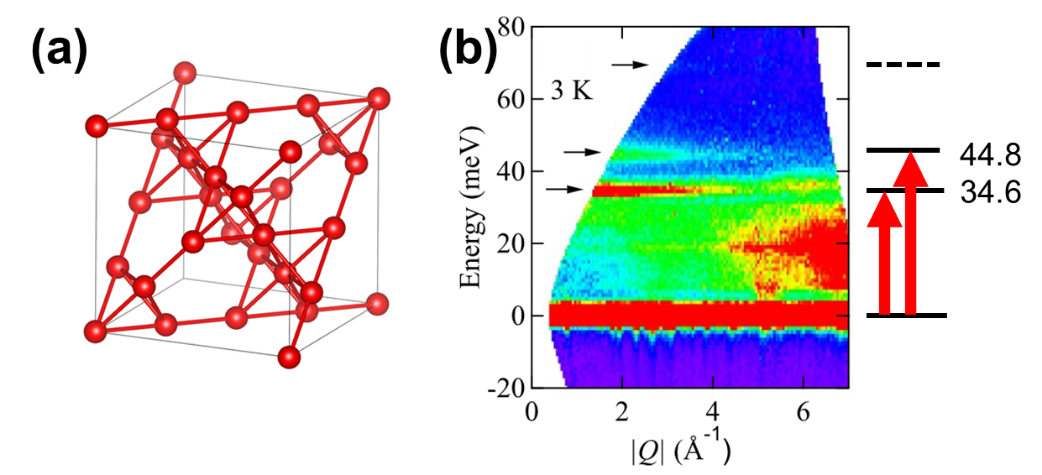
図3: パイロクロア反強磁性体と非弾性散乱スペクトル.
[1] R. Moessner and J. T. Chalker Phys. Rev. Lett. 80, 2929–32 (1998); R. Moessner and J. T. Chalker, Phys. Rev. B 58, 12049–62 (1998).
[2] K. Nawa, R. Murasaki, S. Itoh, H. Saito, H. Nojiri, C. D. Cruz, D. Okuyama, M. Yoshida, D. Ueta, H. Yoshizawa and T. J. Sato, J. Phys.: Condens. Matter 36, 495801 (2024).
◆ 論文等
◆ 論文等
◆ 学位論文
◆ 論文等
◆ 論文等
◆ プレスリリース
◆ その他
◆ プレスリリース
◆ 研究成果
Performance of the Fully Equipped Spin Flip Chopper for the Neutron Lifetime Experiment at J-PARC (名古屋大学 三島賢二他)
中性子は寿命878.4 ± 0.5秒 [10]で陽子、電子、反ニュートリノの3体にβ崩壊する。これは素粒子、原子核、天文分野における重要なパラメーターのうちの一つであるが、その測定手法により測定結果が9.5秒(4.6σ)と大きく乖離しており、“中性子寿命問題 (Neutron Lifetime Puzzle)”と呼ばれている。J-PARC BL05ではこの問題を解決するための新しい中性子寿命測定実験が遂行中である[11]。
この実験では長さ1 mの検出器に中性子を40 cm程度にバンチ化した状態で導入する。このバンチ化にスピンフリップチョッパー(SFC)という装置を用いている。SFCは中性子磁気ミラーとスピンフリッパーの組み合わせからなる。フリッパーのONとOFFを電気的に制御することで、任意の時間に立ち上がり数十マイクロ秒での中性子制御を可能にする。
中性子寿命実験の統計精度はこのSFCの口径で律速していた。本研究ではこのSFCのミラーおよびフリッパーを大型化することにより(Fig.4)、検出器で中性子強度を3倍に増加することに成功した(Fig.5) [12]。その結果、中性子寿命を1秒の精度で測定するために必要な実験期間が590日から170日へと大幅に短縮された。SFCの信号対雑音比(S/N)も250〜400と高く保たれ、従来のチョッパーと比較しても十分な性能が維持されている。本研究成果は、中性子ビームの制御技術における重要な進展であり、今後の中性子寿命の未解決の問題の解決にも寄与する。
[1] S. Navas et al., (Particle Data Group), Phys. Rev. D 110, 030001 (2024).
[2] K. Hirota et al., Prog. Theor. Exp. Phys. 2020, 123C02 (2020).
[3] K. Mishima et al., Prog. Theor. Exp. Phys. 2024, 093G01 (2024).
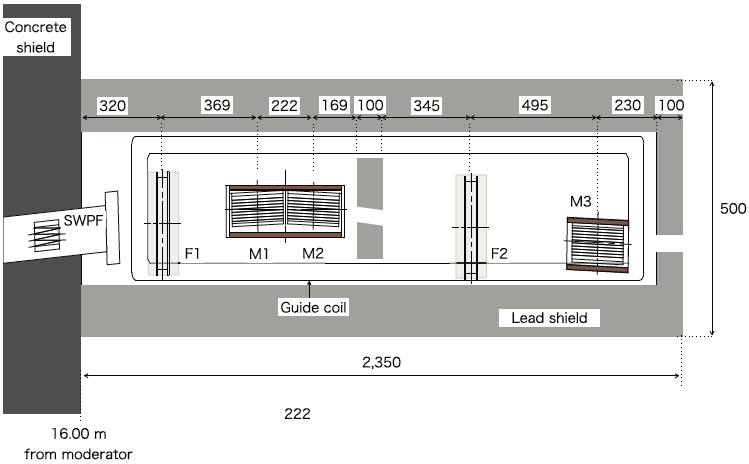
図4: Schematic diagram of the new SFC. It consists of two spin flippers and three stacks of magnetic supermirrors.
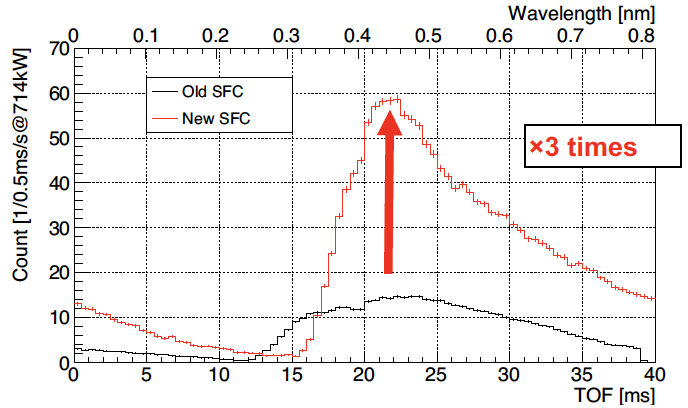
図5: Comparison of the neutron TOF spectra between the old and new SFC. The neutron intensity increased a factor of 3.
◆ 論文等